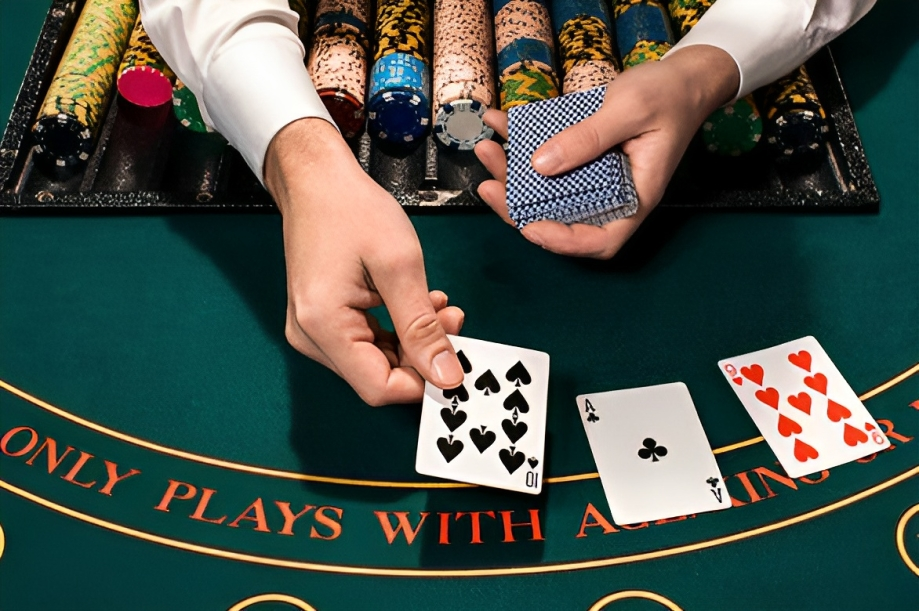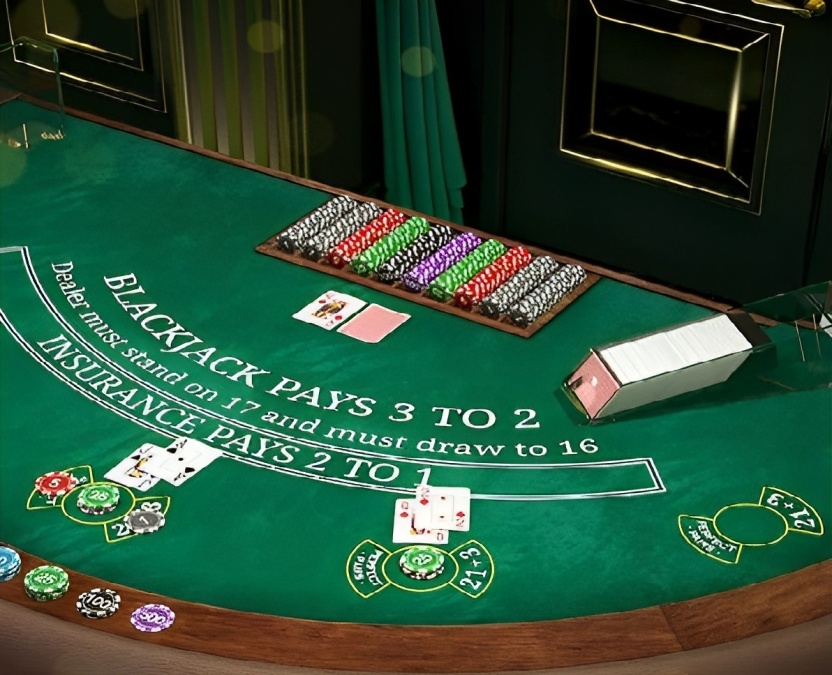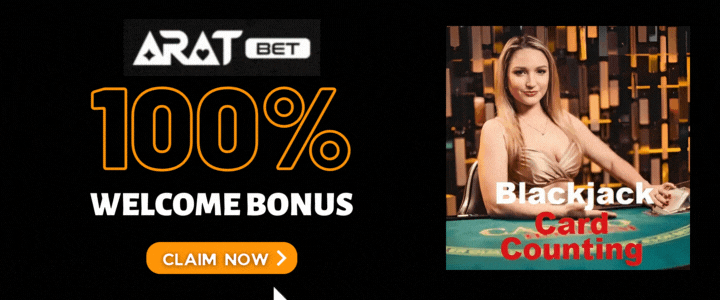
Blackjack Card Counting Strategy is a live by game guide by Phwin77 Casino low medium game volatility, read our Tips and learn Playing Live Blackjack Card Counting Strategy. If you’re seeking to elevate your blackjack skills and maximize your chances of winning, you’re in the right place.
We’ll delve into advanced card-counting strategies that can provide you with a significant edge over the house. Mastering these strategies allows you to make more informed decisions during the game and increase your win rate. So, let’s embark on a journey to become a blackjack pro.
Check out more: Phwin online slot games
Table of Contents
- Blackjack Card Counting Strategy: Details & Information
- Blackjack Card Counting Strategy: Understanding Card Counting
- Blackjack Card Counting Strategy: Card Counting Strategy
- Blackjack Card Counting Strategy: Ace’s Strategy
- Blackjack Card Counting Strategy: Split Strategy
- Blackjack Card Counting Strategy: Insurance and Surrender Timing
- Best Casino to Play Blackjack Card Counting Strategy
- Conclusion
- Popular Casino Bonus: Blackjack Card Counting Strategy
- Frequently Asked Questions (FAQs)
Blackjack Card Counting Strategy: Details & Information
| Casino | Phwin77 |
|---|---|
| Live Type | Table Slots |
| RTP | 99.5% |
| Player Odds of Winning | 42.22% | Dealer Odds of Winning | 49.10% | Tie | 8.48% |
| Volatility | Low |
Blackjack Card Counting Strategy: Understanding Card Counting
Before we dive into the advanced strategies, let’s ensure you have a strong grasp of the basic concepts of card counting. Unlike games such as baccarat, roulette, or Sicbo, where luck often plays a more significant role, blackjack relies more on skill. With less reliance on luck, players can exert more control over their outcomes, making it a game where strategy and decision-making are crucial. Here’s an overview of these advanced strategies.
Check out more: Phwin online fishing Philippines

Blackjack Card Counting Strategy: Card Counting Strategy
1)17 Points
- When your hand totals 17 points, you’re in an intriguing situation. This optimal strategy suggests standing, regardless of the house’s point combination. A total of 17 is a reasonably strong hand, and the risk of busting (exceeding 21) is greater if you hit. By standing, you force the dealer to make decisions and potentially bust if they have a weak hand.
2)13, 14, 15, 16 Points
- For hands totaling 13, 14, 15, or 16 points, your next move depends on the dealer’s face-up card:
- If the dealer’s card is between 2 and 6, it’s generally best to stand. These low-value dealer cards increase the chances of the dealer busting.
- However, if the dealer’s face-up card is a 7, 8, 9, 10, or an Ace, hitting is recommended. The dealer has a higher likelihood of having a stronger hand, and hitting provides an opportunity to improve your own hand.
3)12 Points
- With a hand total of 12 points, you should stand when the dealer has a 4, 5, or 6 showing. These dealer cards are relatively weak, and the odds of the dealer busting are favorable. However, if the dealer’s face-up card is anything other than 4, 5, or 6, hitting is better. The goal is to try and improve your hand because a total of 12 is relatively weak and has a higher risk of busting if you draw a 10-point card.
4)10, 11 Points
When your hand totals 10 or 11 points, your strategy is based on the value of the dealer’s face-up card:
- If the dealer’s face-up card is an Ace, it’s generally advisable to hit if you have 10 points (doubling down isn’t recommended here). Hitting gives you a chance to improve your hand, as you’re less likely to bust.
- However, with 11 points and the dealer’s face-up card being an Ace, it’s recommended to double down. This is a strong position, and doubling down can maximize your potential payout.
- For all other point combinations (10 or 11) when the dealer’s face-up card isn’t an Ace, you should double down. Doubling down is a strategic move aiming to take advantage of your strong starting position and increase your potential winnings.
5)9 Points
If your hand totals 9 points, the strategy depends on the dealer’s face-up card:
- If the dealer’s face-up card is 7, 8, 9, 10, or an Ace, hitting is better. The dealer is more likely to have a stronger hand, and hitting gives you the opportunity to improve your 9-point hand.
- For the rest of the dealer’s face-up cards (2 to 6), doubling down is recommended. Doubling down here is an aggressive move to capitalize on your strong starting position.
6)2 to 8 Points
- For any hand total between 2 and 8 points, the recommended strategy is to hit. These hands are weak, and you have a good chance of improving them by drawing additional cards. While the dealer’s face-up card does play a role in your decision, it’s generally best to hit with these low point totals to work toward a stronger hand.
Check out more: Phwin casino live games
Blackjack Card Counting Strategy: Ace’s Strategy
1)A8, A9 (Ace Eight, Ace Nine)
- With a pair of Aces that total 18 or 19, it’s generally wise to stand, regardless of the house’s points. An Ace paired with an 8 or 9 creates a strong hand that’s already close to 21, which is the best possible total in blackjack.
- Standing in this situation is a strategic move because the odds of drawing a card that would improve your hand further without busting (going over 21) are lower than the odds of the dealer having a hand strong enough to beat yours.
2)A7 (Ace Seven)
- When you have an Ace paired with a 7, it’s typically best to hit if the house’s face-up card is an Ace or a 10-point card (10, Jack, Queen, King). This strategy aims to improve your hand’s total, as hitting here gives you a chance to get a stronger hand without risking busting, considering that you’re starting with a relatively weak hand of 18.
- However, if the dealer’s face-up card is any other value, you should stand. In such cases, the chances of the dealer having a stronger hand are higher, making it safer to keep your 18.
3)A2, A3, A4, A5, A6 (Ace Deuce, Ace Trey, Ace Four, Ace Five, Ace Six)
- When you have an Ace paired with any of these cards (2 through 6), it’s generally advisable to hit. The reason for hitting is to improve your hand and take advantage of the potential to get a stronger total. The combination of an Ace with any of these cards offers more flexibility in terms of drawing additional cards without a significant risk of busting.
Check out more: Phwin casino games guide

Blackjack Card Counting Strategy: Split Strategy
1)A, A (Aces)
- Always split when you have a pair of Aces. Splitting Aces is essential because it gives you the opportunity to form two strong starting hands, each with the potential to reach 21. This greatly increases your chances of winning. When you split Aces, you will typically receive one more card for each Ace, and you can continue to hit or stand on each hand as you normally would. This strategy helps you maximize your chances of getting a blackjack, which pays out at higher odds.
2)10, 10 (Tens)
- With a sum of 20 points when you have a pair of 10s, it’s highly advisable not to split. Keeping your cards together as a total of 20 is already a very strong hand in blackjack. Splitting this pair would mean risking the strength of this hand, and it’s generally better to maintain your strong position and aim for a win with your existing hand.
3)9, 9 (Nines)
- When you have a pair of 9s and the house has an Ace or an 8 showing, it’s recommended not to split. This is because the dealer’s Ace indicates a strong potential
- for the dealer to reach a total of 21, which is difficult to beat. Similarly, if the dealer shows an 8, it’s also a fairly strong hand, and splitting may not be in your best interest. However, if the dealer shows any other card, it’s often a good idea to split the nines to create the possibility of forming two stronger hands.
4)8, 8 (Eights)
- Splitting eights is generally a wise decision. This is because having a pair of eights gives you a weak hand with a total of 16 points, which is not strong enough to stand against most dealer hands. By splitting, you have the chance to improve your position by receiving additional cards for each 8.
5)7, 7 (Sevens)
- When you have a pair of sevens, it’s recommended to split if the dealer’s face-up card has a value between 3 and 8. This strategy takes advantage of the likelihood of improving your position. However, if the dealer has a 9, 10, or an Ace showing, it’s better to keep your sevens as a hard 14, as splitting in this scenario is less advantageous.
6)6, 6 (Sixes)
- Split your pair of sixes when the dealer’s face-up card is between 3 and 7. This strategy aims to capitalize on the dealer’s potentially weak starting hand. However, if the dealer’s card is an 8 or higher, it’s better to keep your pair of sixes together.
7)5, 5 (Fives)
- It’s generally advisable to keep your pair of fives together. Splitting them is not advantageous because you already have a total of 10 points, which is a strong starting hand. There’s no need to risk weakening this position by splitting.
8)4, 4 (Fours)
- Split your pair of fours when the dealer’s face-up card is a 6 or 7. This is based on the principle that these dealer cards are relatively weak, and by splitting, you have the opportunity to create two better hands. However, if the dealer shows any other card, it’s better to keep your fours together.
9)3, 3 (Threes)
- Split your pair of threes if the dealer’s face-up card is between 3 and 8. Splitting in this scenario aims to take advantage of the dealer’s potential weakness. However, if the dealer’s card is a 9, 10, or an Ace, it’s better to keep your threes together.
10)2, 2 (Twos)
- Just like with a pair of fives, it’s usually better to keep your twos together. Splitting them doesn’t provide a significant advantage because you already have a total of 4 points, and splitting may weaken your overall position.
Blackjack Card Counting Strategy: Insurance and Surrender Timing
1.Insurance
- Insurance comes into play when the house has an Ace showing. To protect against the possibility of the dealer hitting blackjack, players can pay half their bet as insurance.
- If the dealer gets a blackjack, the insurance pays out at 1 to 2 odds; otherwise, the bet goes to the dealer for the next phase of the game. The timing for insurance is crucial.
- To make the right decision, consider the number of face cards remaining, as it significantly affects the odds.
2.Surrender Timing
- In most casinos, players can choose to surrender and recoup half of their bet, regardless of the cards they’re facing. The most common scenario for surrender is when the house holds an Ace.
- Surrendering when the dealer has an Ace is often the best option, as it can be challenging to beat an Ace combined with a 10, 9, or 8. Once you’ve considered insurance, surrendering becomes a strategic move.
Best Casino to Play Blackjack Card Counting Strategy

Best Casino to play Blackjack is Phwin. When you’re ready to apply these advanced strategies, we recommend the Phwin77 Casino. This reputable establishment offers the perfect environment to hone your blackjack skills. With a wide range of blackjack tables and professional dealers, you’ll find an ideal setting to implement your newfound expertise.
Conclusion
In conclusion, mastering these advanced card-counting strategies can significantly enhance your blackjack gameplay. By understanding when to stand, hit, double down, split, and when to use insurance or surrender, you can boost your win rate and take control of your destiny at the blackjack table. Best of luck, and may your cards be ever in your favor!
Popular Casino Bonus: Blackjack Card Counting Strategy
Frequently Asked Questions (FAQs)
1. What is the purpose of card counting in blackjack?
- Card counting in blackjack is used to gain an advantage over the house by keeping track of the ratio of high-value to low-value cards left in the deck. This helps players make more informed decisions during the game and increase their win rate.
2. When should I stand with a hand totaling 17 points?
- You should stand on a hand with 17 points regardless of the dealer’s point combination. It’s considered a reasonably strong hand, and hitting might increase the risk of busting.
3. What should I do if I have a pair of Aces in blackjack?
- When you have a pair of Aces, it’s best to split them. Splitting Aces gives you the opportunity to form two strong hands, each with the potential to reach 21.
4. When is it advisable to double down in blackjack?
- You should double down when your hand totals 10 or 11 points, except when the dealer’s face-up card is an Ace. In that case, it’s recommended to hit with 10 points and double down with 11 points.
5. Is it a good strategy to split a pair of 10s in blackjack?
- No, it’s generally not advisable to split a pair of 10s. Keeping them together as a total of 20 is already a strong hand, and splitting risks weakening your position.
6. When is the right time to use insurance in blackjack?
- Insurance is used when the dealer has an Ace showing. It’s a bet that protects against the dealer hitting blackjack. The timing for insurance is crucial and should be considered based on the number of face cards remaining in the deck.
7. In which scenario should I surrender in blackjack?
- Surrendering is often a good choice when the dealer holds an Ace. It can be challenging to beat an Ace combined with a 10, 9, or 8. Surrendering allows you to recoup half of your bet.
8. Why is Phwin77 Casino recommended for playing blackjack?
- Phwin77 Casino is recommended because it offers a wide range of blackjack tables and professional dealers, providing an ideal environment to implement advanced blackjack strategies and enhance your gameplay.
9. How does card counting in blackjack differ from games like baccarat or roulette?
- Card counting is more applicable in blackjack because it relies less on luck and more on skill and strategy. In games like baccarat or roulette, luck plays a more significant role.
10. What is the significance of having low volatility in a blackjack game?
- Low volatility in blackjack means that the game offers more stability and less risk. Players have greater control over their outcomes and can make strategic decisions to increase their win rate.
Related Posts
Written By:

Steven Cheng
Blog Manager at Phwin Online Casino
As the Blog Manager at Phwin Online Casino, a prominent player in the Philippines’ online casino scene, Steven has carved a niche for himself by seamlessly blending his profound understanding of the industry with his creative flair for content management.
Steven’s journey in the world of online casinos has been marked by his commitment to delivering accurate and relevant information to the casino’s community. His thoughtful approach to content curation and his knack for maintaining an interactive online environment have fostered a sense of trust and camaraderie among the casino’s patrons.
The information provided in this blog post is for general informational purposes only. The content is not intended to be a substitute for professional advice, guidance, or assistance. Always seek the advice of a qualified expert or professional before making any decisions or taking any actions based on the information provided in this blog post.
By accessing and using this blog post, you agree to be bound by the terms and conditions outlined in this disclaimer. If you do not agree with any part of this disclaimer, please refrain from using the information provided in this blog post.
This disclaimer is subject to change without notice.







